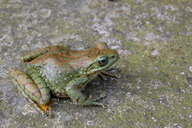|
Amolops mantzorum (David, 1872)
| family: Ranidae genus: Amolops |
 © 2008 LI Cheng (1 of 1)
|
|
|
|
Description Amolops tuberodepressus measures up to 56.7 mm in SVL in males, and 71.1 mm in females. It has a flat, depressed head with distinct canthi and a rounded snout which projects beyond the lower jaw. The tympanum is distinct and covered with smooth skin. A narrow, slightly curved supratympanic fold runs from the posterior corner of the eye to the shoulder. Vomerine teeth are present in two obliquely oriented rows. The body is depressed and slender, with smooth skin except for numerous flattened tubercles on the flank (for which the species is named), a few flat tubercles on the dorsum, and many small tubercles surrounding the vent. Dorsolateral folds are absent (Liu and Yang 2000). The forelimbs are moderately long. Fingers are slender and the relative finger length is III>I=IV>II. Large discs with circummarginal grooves are present on the three outer fingers, and a small disc with no grooves is present on the first finger. The third finger disc is larger in diameter than the tympanum. Subarticular tubercles are rounded and prominent, and there are large supernumerary tubercles at the bases of the three outer fingers. Palmar tubercles are flattened and fused. Velvety, brownish gray nuptial pads are also present in males. The hindlimbs are long, with the relative finger length being IV>III=V>II>I. All toes have discs with circummarginal grooves, and are fully webbed except the fourth, which is partially webbed. The inner first toe and outer fifth toe are fringed. While the subarticular tubercles are well-developed, the inner metatarsal tubercle is small and the outer metatarsal tubercle is lacking (Liu and Yang 2000). Amolops tuberodepressus is brown with round or irregular green to bluish-green spots. The head is more green than brown, while the posterior dorsum is more brownish. The sides of the head and body are green with brown spots. Dorsal surfaces of the limbs are green with brown crossbars, while the ventral surfaces of the limbs are yellow with occasional black-gray. Webbing is yellow to orange-yellow. The belly is cream with a yellowish tinge, fading to gray laterally and on the chest. The iris is brown with yellow spotting (Liu and Yang 2000). In general, females are larger in overall size, while the forelimbs of the males are larger. Males lack vocal sacs but have nuptial pads, which are brownish gray and velvety and cover the entire dorsal and medial surfaces of the first fingers (Liu and Yang 2000). Distribution and Habitat Country distribution from AmphibiaWeb's database: Bhutan, China
The species occurs in the Trans-Himalayas Range in China. It is common in the Wuliang and Ailao Mountains of Jingdong County, Yunnan Province. It resides in wet subtropical broadleaf evergreen forests, on rocks in mountain streams or adjacent to cascades (Liu and Yang 2000). Life History, Abundance, Activity, and Special Behaviors The frogs flatten themselves onto rocks in mountain brooks or beside cascades. When disturbed, the frogs immediately jump into the water (Liu and Yang 2000). Breeding takes place in June and July (Rao and Wilkinson 2007). Comments The specific epithet tuberodepressus is derived from the Latin noun tuber, for tubercle, and the Latin adjective depressus, meaning flat. The karyotype is 2N=26. Karyological characters unique to this species include a strong secondary constriction on the short arm of chromosome pair 2, near the centromere, as well as a distinct secondary constriction in the middle of the short arm of chromosome pair 3. Also, no sex-related heteromorphic or supernumerary chromosomes were observed for this species. In common with other Amolops from southwestern China, a secondary constriction is present in the middle of the short arm of chromosome pair 6 (Liu and Yang 2000).
References
Liu, W., and Yang, D. (2000). ''A new species of Amolops (Anura: Ranidae) from Yunnan, China, with a discussion of karyological diversity in Amolops.'' Herpetologica, 56(2), 231-238. Rao, D., and Wilkinson, J. (2007). ''A new species of Amolops (Anura: Ranidae) from southwest China.'' Copeia, 2007(4), 913-919. Originally submitted by: Keith Lui (first posted 2012-07-20) Edited by: Kellie Whittaker (2012-07-20) Species Account Citation: AmphibiaWeb 2012 Amolops mantzorum <https://amphibiaweb.org/species/4655> University of California, Berkeley, CA, USA. Accessed Jan 24, 2025.
Feedback or comments about this page.
Citation: AmphibiaWeb. 2025. <https://amphibiaweb.org> University of California, Berkeley, CA, USA. Accessed 24 Jan 2025. AmphibiaWeb's policy on data use. |




 Map of Life
Map of Life